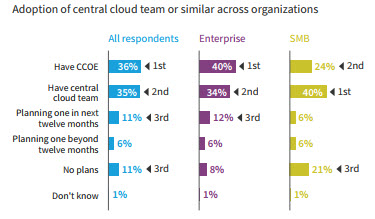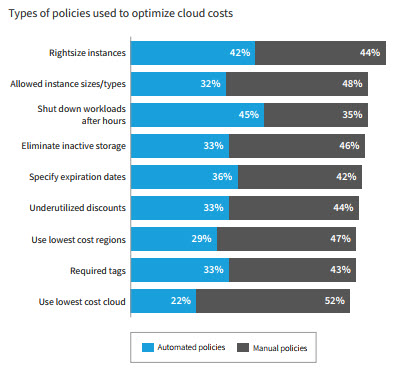
FinOps is an evolving cloud financial management discipline and cultural practice. It enables organizations to get maximum business value by helping engineering, finance, technology, and business teams to collaborate on data-driven spending decisions.
The term is a combination of “Financial” and “Operations”. It refers to a cross-functional approach that bridges the gap between finance, operations, and cloud teams.

With Azure FinOps, organizations can gain greater visibility into their cloud spend, improve cost management, and optimize their cloud usage.
In the last edition of the report, Flexera surveyed over 750 global IT professionals to understand their cloud adoption and usage.
Report: “State of the Cloud”, Flexera, 2022
The Need for Azure FinOps
Cloud computing has become a fundamental part of modern IT infrastructure. While Azure provides significant benefits, it also introduces new challenges around managing cloud costs.
In this blog post, we will explore some of the key aspects of Azure FinOps, such as:
- Benefits of FinOps for Azure
- FinOps operating model and process
- Azure solutions, offers and tools for FinOps
- Customer experiences and best practices for optimizing FinOps with Azure
Benefits of FinOps for Azure
The report also found that in Europe, 58% of organizations fall under Heavy cloud users category, compared to USA where that number is 63%.
Report: “State of the Cloud”, Flexera, 2022
FinOps can help customers achieve several benefits when using Azure as their cloud platform, such as:
– Reducing cloud costs by gaining visibility into cloud spending, identifying waste and inefficiencies.
Applying governance policies and controls, optimizing resource utilization and performance, leveraging discounts and incentives, etc.
– Increasing business value by aligning cloud spending with business objectives and priorities.
Enabling faster delivery of products and services, fostering innovation and experimentation, improving customer satisfaction and retention, etc.
– Enhancing collaboration by breaking down silos between different teams and stakeholders involved in cloud decision-making.
Foster process of cloud decision-making, establishing common metrics and KPI’s. Enhancing operations by sharing best practices and learning’s, creating feedback loops and accountability mechanisms, etc.
Wasted cloud spend is a major issue and becomes more critical as cloud costs continue to rise. Respondents self-estimated that their organizations waste 32% of cloud spend (up from 30% last year).
Report: “State of the Cloud”, Flexera, 2022
However, spend is likely less efficient and likely even higher on average, as many organizations tend to underestimate their amount of waste.
Key Principles of Azure FinOps
Azure FinOps is built around three key principles:
- Visibility: Organizations need to have visibility into their cloud usage to understand where and how they are spending their money.
- Accountability: Teams are accountable and need to understand the impact of their actions related to cloud costs.
- Optimization: Organizations need to continually optimize their cloud usage to drive greater efficiency and cost savings.
You can run a free self-cost management assessment on your environment to examine your efficiency.
For more information, see Azure Well-Architected Review | Assessments
Operating Model and Process
This is not a one-time project or a static state. It is an ongoing practice that requires a clear operating model and process to ensure continuous improvement. Its a framework for organizing and structuring cloud cost management practices within an organization. It provides a set of roles, processes, and tools for managing cloud costs and aligning them with business objectives.
The FinOps Operating Model includes the following key components:
- FinOps Team: This is the team responsible for managing cloud costs and driving cost optimization within the organization.
This team includes a mix of roles, such as Cloud Architects, Financial Analysts, and DevOps Engineers. They all work together to establish cloud cost management practices and ensure ongoing cost optimization. - Cost Center: This is the organizational unit responsible for cloud cost management within the organization.
It is typically aligned with a business unit or team and is responsible for managing the cloud resources. One of the responsibilities is managing the budget for cloud resources, tracking cloud costs, and alignment with business objectives. - FinOps Process: This is the set of processes and tools used to manage costs and optimize usage within the organization.
Subsequently includes activities such as, monitoring usage, identifying cost optimization opportunities, establishing cost allocation methodologies, and tracking costs over time.
The FinOps Process typically follows a set of steps, which may include:
- Establishing a baseline for cloud costs and usage
- Monitoring cloud usage and costs in real-time
- Identifying cost optimization opportunities and implementing optimization strategies
- Establishing cost allocation methodologies and reporting on cloud costs
- Regularly reviewing and adjusting cloud cost management practices to ensure ongoing cost optimization
Azure FinOps Best Practices
Some of the key best practices include:
- Establish a cross-functional team: An effective approach requires collaboration across finance, operations, and cloud teams to drive accountability and optimization.

- Define cloud cost policies: Organizations should define clear policies around cloud costs that align with business goals and enable effective decision-making.

- Monitor and optimize cloud usage: By monitoring cloud usage and implementing optimization strategies, organizations can avoid cloud waste and reduce costs.
- Use Azure cost management tools: Azure provides a set of cost management tools that can help organizations gain greater visibility and control over their cloud costs.
- Continuously evaluate and adjust: To drive ongoing cost optimization, organizations should continuously evaluate their cloud usage and adjust their approach based on new data and insights.
Conclusion
Azure FinOps is a critical approach for organizations that want to optimize their cloud spend on the Microsoft Azure platform. By following best practices and principles that align with visibility, accountability, and optimization, organizations can drive significant cost savings and improve their cloud usage.
Ultimately, Azure FinOps is an essential part of any organization’s cloud strategy, enabling them to make the most of the benefits that cloud computing provides.
In the follow-up article, we will look at some of the Microsoft Azure related tools, practices, trainings related to the FinOps discipline.



Be the first to comment